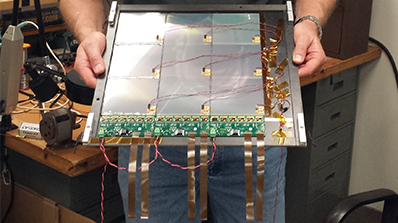An NNSS Site-Directed Research and Development (SDRD) project, led by Principal Scientist J. Andrew Green, has been selected as a finalist for a 2018 R&D 100 Award. The project, silicon strip cosmic muon detectors, registers muon occurrences, enabling muon trackers to detect shielded nuclear materials, explosives and other items of interest.
“It’s an extraordinary accomplishment to see this technology emerge from the world of high-energy physics, colliders and the like, and into significant homeland security applications and be recognized as such by the R&D 100 [Awards] Committee,” said Howard Bender, SDRD program manager.
Maritime security is becoming an increasingly important issue for our nation. Nearly seven million cargo containers arrive annually in American seaports. Our enemies could use these containers to smuggle nuclear weapons or special nuclear material into our country.
Concrete, lead and other materials can conceal these threats from radiation detectors and X-ray scanners. Muons (secondary particles that travel down to the Earth’s surface, arriving at a wide variety of angles and energies when cosmic rays collide with the Earth’s atmosphere) can penetrate these shields, and a muon tracker can inform threat vs. non-threat scenarios. Silicon strip muon detectors are an enabling technology for muon trackers, thereby aiding our nation’s homeland security.
Green, along with two co-workers and several collaborators from Fermi National Accelerator Laboratory and Los Alamos National Laboratory (LANL), have improved on drift tube–based technology that has been used in muon detector systems. With a slim profile, silicon strip muon detectors can be stealthily embedded in structures or vehicles. Lightweight silicon strip detectors are easily handled or transported by humans or robots. Their precision dramatically reduces tracking and calibration software requirements. Furthermore, without the high voltage and potentially flammable gas used in drift tubes, these detectors can be deployed without safety concerns. With silicon strip muon detectors, the potential applications are endless.
The NNSS has previously won three R&D 100 awards (High-Resolution Holography Lens, Multiplexed Photonic Doppler Velocimeter, and Geometrically Enhanced Photocathodes), and was a finalist for the Argus Fisheye Probe. The NNSS collaborated with LANL on two R&D 100 winners – MOXIE (movies of extreme imaging experiments) and KiloPower.
The R&D 100 Awards Committee and R&D Magazine recently announced the 2018 R&D 100 Award finalists, marking the 56th year of the program. The prestigious R&D 100 Awards honor the most innovative technologies of the past year. The finalists were selected by an independent panel of more than 50 judges representing R&D leaders in a variety of fields. This year’s R&D 100 winners will be announced at the annual black-tie awards dinner on Nov. 15 at the Waldorf Astoria Orlando in Orlando, Fla.

